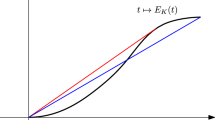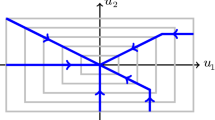Abstract
This paper is concerned with a space-time discretization of a rate-independent evolution governed by a non-smooth dissipation and a non-convex energy functional. For the time discretization, we apply the local minimization scheme introduced in Efendiev and Mielke (J Convex Anal 13(1):151–167, 2006), which is known to resolve time discontinuities, which may show up due to the non-convex energy. The spatial discretization is performed by classical linear finite elements. We show that accumulation points of the sequence of discrete solutions for mesh size tending to zero exist and are so-called parametrized solutions of the continuous problem. The discrete problems are solved by means of a mass lumping scheme for the non-smooth dissipation functional in combination with a semi-smooth Newton method. A numerical test indicates the efficiency of this approach. In addition, we compared the local minimization scheme with a time stepping scheme for global energetic solutions, which shows that both schemes yield different solutions with differing time discontinuities.


Similar content being viewed by others
References
Attouch, H.: Variational Convergence for Functions and Operators. Pitman Advanced Publishing Program, Boston (1984)
Efendiev, M.A., Mielke, A.: On the rate-independent limit of systems with dry friction and small viscosity. J. Convex Anal. 13(1), 151–167 (2006)
Gaspoz, F.D., Heine, C.-J., Siebert, K.G.: Optimal grading of the newest vertex bisection and \(H^1\)-stability of the \(L^2\)-projection. IMA J. Numer. Anal 36(3), 1217–1241 (2016)
Hinze, M., Pinnau, R., Ulbrich, M., Ulbrich, S.: Optimization with PDE Constraints, vol. 23. Springer, Berlin (2008)
Ito, K., Kunisch, K.: Lagrange multiplier approach to variational problems and applications. SIAM, Philadelphia (2008)
Knees, D.: Convergence Analysis in Time-Discretization Schemes for Rate-Independent Systems. Version: (2017)—submitted to ESAIM:COCV. https://arxiv.org/pdf/1712.06851.pdf
Knees, D., Rossi, R., Zanini, C.: A vanishing viscosity approach to a rate-independent damage model. Math. Models Methods Appl. Sci. 23(04), 565–616 (2013)
Mielke, A.: Energetic formulation of multiplicative elasto-plasticity using dissipation distances. Contin. Mech. Thermodyn. 15(4), 351–382 (2003)
Mielke, A.: Differential, energetic, and metric formulations for rate-independent processes. Nonlinear PDE’s Appl. 2028, 87–167 (2011)
Mielke, A., Paoli, L., Petrov, A., Stefanelli, U.: Error estimates for space-time discretizations of a rate-independent variational inequality. SIAM J. Numer. Anal. 48(5), 1625–1646 (2010)
Mielke, A., Roubíc̆ek, T.: Numerical approaches to rate-independent processes and applications in inelasticity. ESAIM: M2AN 43(3), 399–428 (2009)
Mielke, A., Roubíc̆ek, T.: Rate-Independent Systems: Theory and Application. Springer, New York (2015)
Mielke, A., Rossi, R., Savaré, G.: BV solutions and viscosity approximations of rate-independent systems. ESAIM: Control Optim. Calc. Var. 18(1), 36–80 (2012)
Mielke, A., Rossi, R., Savaré, G.: Balanced viscosity (BV) solutions to infinite-dimensional rate-independent systems. J. Eur. Math. Soc. 18, 2107–2165 (2016)
Mielke, A., Theil, F.: On rate-independent hysteresis models. NoDEA: Nonlinear Differ. Equ. Appl. 11(2), 151–189 (2004)
Mielke, A., Zelik, S.: On the vanishing-viscosity limit in parabolic systems with rate-independent dissipation terms. Ann. Sc. Norm. Super. Pisa Cl. Sci. 13(1), 67–135 (2014)
Negri, M.: Quasi-static rate-independent evolutions: characterization, existence, approximation and application to fracture mechanics. ESAIM Control Optim. Calc. Var. 20(4), 983–1008 (2014). https://doi.org/10.1051/cocv/2014004
Negri, M., Scala, R.: A quasi-static evolution generated by local energy minimizers for an elastic material with a cohesive interface. Nonlinear Anal. Real World Appl. 38, 271–305 (2017)
Acknowledgements
The authors are very grateful to Dorothee Knees (University of Kassel) for various helpful discussions.
Author information
Authors and Affiliations
Corresponding author
Additional information
Publisher's Note
Springer Nature remains neutral with regard to jurisdictional claims in published maps and institutional affiliations.
This research was supported by the German Research Foundation (DFG) under Grant No. HE 6077/8-1 within the priority program Non-smooth and Complementarity-based Distributed Parameter Systems: Simulation and Hierarchical Optimization (SPP 1962).
Appendices
A Proof of Lemma 3.2
We start the proof of Lemma 3.2 with the following result, which is a direct consequence of the characterization of \(z^{\tau ,h}_k\) as a minimizer of (3.1). (This is actually the only point, where one uses that \(z^{\tau ,h}_k\) is a minimizer and not only a stationary point satisfying (3.3)–(3.6).)
Lemma A.1
(Local energy-inequality) For all \(h,\tau >0\) and all \(k \in {\mathbb {N}}\), the inequality
is valid.
Proof
By optimality of \(z_{k}^{\tau ,h}\) and feasibility of \(z_{k-1}^{\tau ,h}\) for the minimization problem in (3.1), we obtain
Adding \({\mathcal {I}}(t_{k}^{\tau ,h},z_{k}^{\tau ,h})\) on both sides then gives the result. \(\square \)
The local energy inequality is now used to derive the uniform bounds on energy and dissipation in Lemma 3.2.
Proof (of Lemma 3.2)
Again we suppress the superscript \(\tau , h\) in the proof to shorten the notation, except for \(z_0^{\tau ,h}\) in order to avoid confusion with the initial value. Estimating the right hand side in (A.1) by employing (2.4) gives
Using the non-negativity of \({\mathcal {R}}_h\) by (2.16) in combination with (A.2) yields \({\mathcal {I}}(t_{k-1},z_{k}) \le {\mathcal {I}}(t_{k-1},z_{k-1})\) so that
is obtained. By exploiting once again \({\mathcal {R}}_h \ge 0\), this implies
such that induction over k already gives the desired result for the energy:
To include the dissipation in the estimate, we sum up (A.3) to obtain
Inserting (A.4) and adding \(\beta \) on both sides, we finally obtain
which is the claimed estimate. \(\square \)
B Proof of the discrete energy identity in Lemma 3.8
We follow the lines of [6] and start with the proof of (3.41). From (3.3), (3.4), and the binomial formula, we infer
For arbitrary \(k\in \{1, \ldots , N-1\}\), we thus deduce from (3.3) and (3.37) that
where we employed the definition of the constant interpolants in (3.35). This gives (3.41) for almost all \(s\in (0,s^{\tau ,h}_{N-1})\). As seen at the end of the proof of Lemma 3.7, it holds \(\lambda ^{\tau ,h}_N = 0\) so that (B.1) implies the assertion for \(s\in (s^{\tau ,h}_{N-1}, S_{\tau ,h})\).
Next we turn to the discrete energy-identity. Since the affine interpolants in (3.34) are by construction elements of \(W^{1,\infty }((0,S_{\tau ,h}))\) and \(W^{1,\infty }((0,S_{\tau ,h});{\mathcal {Z}})\), respectively, and due to \({\mathcal {I}}\in C^1([0,T] \times {\mathcal {Z}})\) by assumption, the chain rule is applicable and gives for \(s \in [s_{k-1}^{\tau ,h},s_k^{\tau ,h})\) that
From (3.5), we have in combination with the 1-homogeneity of \({\mathcal {R}}_h\) that
Note that, in case of \(k<N\), the last equation results from \(s_{k}^{\tau ,h}- s_{k-1}^{\tau ,h}= \tau \), while, for the case \(k=N\), it follows from \(\lambda _N^{\tau ,h}= 0\) and (B.1), similarly to above. By taking into account the definition of \(r_{\tau ,h}\) in (3.40), integration over \((\sigma _1,\sigma _2)\) then yields (3.39).
It remains to estimate \(r_{\tau ,h}\). To this end, first observe that the definition of the affine and constant interpolants in (3.34) and (3.35) implies for every \(k\in \{1, \ldots , N\}\) and every \(s \in [s_{k-1}^{\tau ,h},s_k^{\tau ,h})\) that
which is frequently used in the following estimates. Now, let \(k \in \{1, \ldots , N\}\) and \(s\in [s_{k-1}^{\tau ,h},s_k^{\tau ,h})\) be arbitrary. Then, by inserting the concrete form of \({\mathcal {I}}\) into the definition of \(r_{{\tau ,h}}\) in (3.40) and employing the coercivity of A together with \((s-s_k^{\tau ,h})<0\), we arrive at
We apply Lemma 3.5 with \(\varepsilon = \alpha /2\) to the second term on the right hand side to obtain
where we also used the positive homogeneity of \({\mathcal {R}}_h\). By inserting this in (B.2) and using again that \((s-s_k^{\tau ,h})<0\), one deduces
Integrating and exploiting the definition of \(\hat{z}_{\tau ,h}\) and \(\hat{t}_{\tau ,h}\), respectively, then yields
Thanks to Lemma 3.2, the bracket on the right hand side is bounded independent of \(\tau \) and h so that (3.42) is proven, too. \(\square \)
C Auxiliary results from convex analysis
In this section, we collect some useful properties of \({\mathcal {R}}\) and \({\mathcal {R}}_h\), respectively. We start with the following lemma, whose proof is straight forward and therefore omitted:
Lemma C.1
Let \({\mathcal {W}}\) be a normed vector space and \({\mathcal {J}}: {\mathcal {W}}\rightarrow {\mathbb {R}}\) a convex and positive 1-homogeneous functional. Then it holds
where \(I_{\partial {\mathcal {J}}(0)}\) denotes the indicator functional of \(\partial {\mathcal {J}}(0)\).
Remark 4
Since only convexity and positive homogeneity is required for Lemma C.1 to hold, we may apply the above results to \({\mathcal {R}}\), its approximation \({\mathcal {R}}_h\), and \({\mathcal {R}}_h \circ \varPi _h\), considered as operators on \({\mathcal {V}}\) as well as \({\mathcal {Z}}\).
As in the proof of Lemma 3.1, we abbreviate \({\mathcal {R}}_{\tau ,h} = {\mathcal {R}}_h \circ \varPi _h + I_\tau \), where \(I_\tau \) is as defined in (3.8). Analogously, we set \({\mathcal {R}}^h_\tau := {\mathcal {R}}_h + I_\tau (v)\).
Lemma C.2
For every \(\eta \in {\mathcal {V}}^*\), there holds
where \({\text {dist}}_{{\mathcal {V}}^*}\{\eta ,\varPi _h^* \partial {\mathcal {R}}_h(0)\} = \inf \{||\eta -\varPi _h^* w||_{{\mathbb {V}}^{-1}} \, : \, w \in \partial {\mathcal {R}}_h(0)\}\) and \( ||\eta ||_{{\mathbb {V}}^{-1}}^2 = \left\langle \eta , {\mathbb {V}}^{-1} \eta \right\rangle \).
Proof
We use the inf-convolution formula (see [1, Prop. 3.4]), which is applicable, since \({\mathcal {R}}_h \circ \varPi _h\) is continuous. This gives
For \(I_\tau ^*\), direct calculation leads to
To calculate the conjugate functional of \(({\mathcal {R}}_h\circ \varPi _h)^*\), note that by the linearity of \(\varPi _h\) the composition \({\mathcal {R}}_h \circ \varPi _h\) is again convex and 1-homogeneous. Therefore, Lemma C.1 gives \(({\mathcal {R}}_h \circ \varPi _h)^*(\eta ) = I_{\partial ({\mathcal {R}}_h\circ \varPi _h)(0)}(\eta )\). The chain-rule for subdifferentials yields \(\partial ({\mathcal {R}}_h \circ \varPi _h)(0) = \varPi _h^* \partial {\mathcal {R}}_h(0)\) so that we obtain
Inserting this together with (C.7) in (C.6) finally yields
which is (C.5). \(\square \)
Lemma C.3
Let \(v \in {\mathcal {V}}\) be arbitrary. Then, \(\xi \in {\mathcal {V}}^*\) is an element of \(\partial I_\tau (v)\), iff there exists a multiplier \(\lambda \in {\mathbb {R}}\) such that \( \xi = \lambda {\mathbb {V}}v \) and
Proof
According to a classical result of convex analysis in combination with (C.7), it holds
Now, the Cauchy–Schwarz-Inequality implies \(\left\langle \xi , v \right\rangle = \left\langle {\mathbb {V}}({\mathbb {V}}^{-1}\xi ) , v \right\rangle \le ||\xi ||_{{\mathbb {V}}^{-1}} ||v||_{\mathbb {V}} \le \tau ||\xi ||_{{\mathbb {V}}^{-1}}\) so that the equivalence in (C.8) can only hold if \({\mathbb {V}}^{-1}\xi = \lambda v\) for some \(\lambda \in {\mathbb {R}}\). Inserting this into (C.8), we conclude that \(\lambda \ge 0\). Moreover, if \(||v||_{\mathbb {V}}< \tau \), then \(\xi = 0\) so that \(\lambda \) fulfills also \(\lambda (||v||_{\mathbb {V}}- \tau ) = 0\) as claimed. \(\square \)
Rights and permissions
About this article
Cite this article
Meyer, C., Sievers, M. Finite element discretization of local minimization schemes for rate-independent evolutions. Calcolo 56, 6 (2019). https://doi.org/10.1007/s10092-018-0301-4
Received:
Accepted:
Published:
DOI: https://doi.org/10.1007/s10092-018-0301-4




